The Apple iPhone 6s and iPhone 6s Plus Review
by Ryan Smith & Joshua Ho on November 2, 2015 8:00 AM EST- Posted in
- Smartphones
- Apple
- Mobile
- SoCs
- iPhone 6s
- iPhone 6s Plus
Battery Life
With any smartphone, battery life is always one of the most important considerations. It probably goes without saying that more battery life is always better. In the case of the iPhone 6s, battery life is especially important to examine because this year Apple has actually made the battery of their phone smaller than before. Normally, it’s almost a given that battery size will be at least constant or increase but in order to accommodate additional components like the Taptic engine the battery has been made smaller. In light of this reversal one might assume that battery life has decreased as a result, but given the move to a FinFET process and other major component improvements it’s hard to say how battery life has increased or decreased. In order to test this properly, we ran the iPhone 6s’ through our suite of battery life tests to try and get an idea for overall battery life. As always, we run all battery life tests with the display set to an average of 200 nits and all possible background tasks disabled.
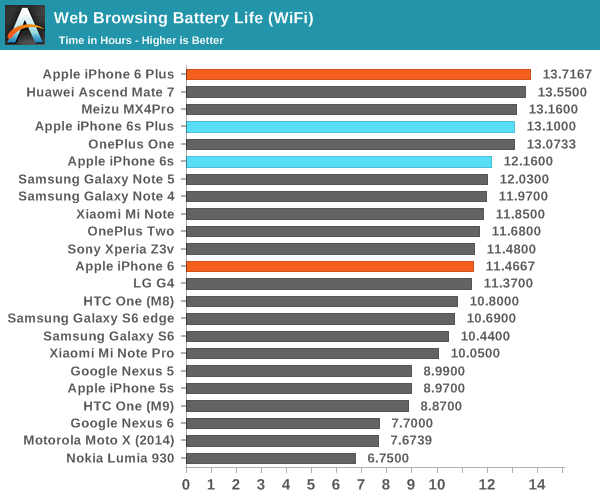
Our first test is WiFi web browsing, and here we see a pretty curious trend. The iPhone 6s Plus appears to regress relative to the iPhone 6 Plus, yet the iPhone 6s solidly beats the iPhone 6. I was pretty confused by this, but it’s likely that we’re seeing these results because the iPhone 6s is going to have larger relative power consumption of the SoC when compared to the display. As the display becomes bigger, the effects of SoC efficiency are just harder to notice, which also explains why it looks like the iPad Air 2 has effectively the same battery life whether you’re running just a blank display or our web browsing test. Both of our review units use a TSMC A9, so I don’t think we can attribute a foundry difference to the odd results that we’re seeing here.
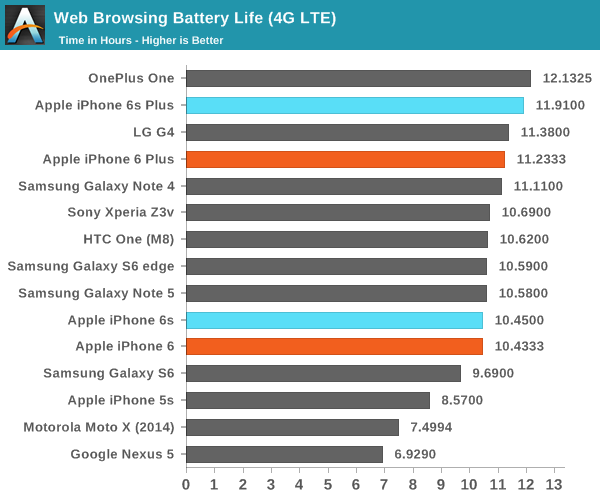
In LTE web browsing, we see a smaller improvement than what we observed in the WiFi test. This might seem strange, but given that the move from a 28nm process to a 20nm process on the modem from iPhone 6 to 6s didn’t come with FinFET it makes sense that the modem will remain a significant power drain. It’s likely that the next big jump in battery life here will come with FinFET process technology on the modem, along with other general modem design improvements.
In order to also look at battery life in more extreme scenarios, we use Basemark OS II and GFXBench to really place a strong stress on the CPU and GPU to see what power draw is like under sustained load. This also allows us to see the extent to which various components of the phone throttle down in response to relatively high sustained loads. However, it’s important to note that the Basemark OS II performance score here isn’t necessarily as accurate as scores from Android devices as the battery score can be calculated with 98 data points instead of 80 as battery score is partially derived from the rate at which the battery percentage decreases. It's also worth noting that in GFXBench there are two data points removed as the low power popup causes an incorrect frame rate to be recorded.
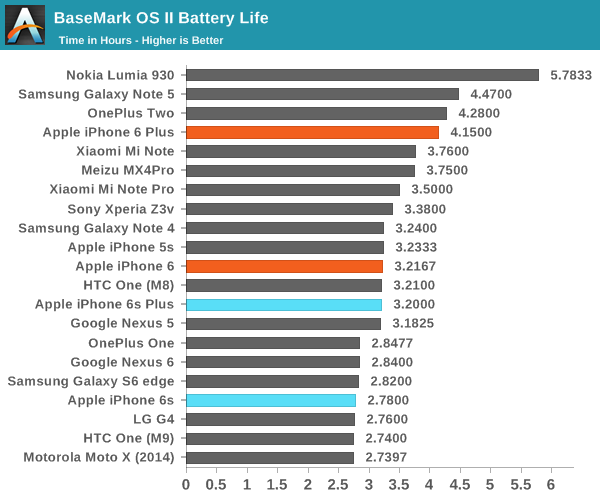
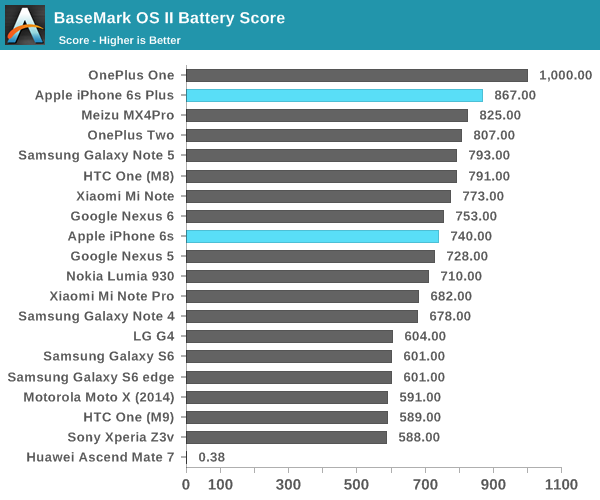
In Basemark OS II, we start off with a pretty shocking result as the iPhone 6s lasts less than three hours in this test, but looking at the battery score it’s pretty clear that the reason why the iPhone 6s doesn't last very long is because it’s running with relatively little throttling throughout the test, so the battery score is high as a result. The same is true of the iPhone 6s Plus, but the larger battery helps it to last a bit longer.
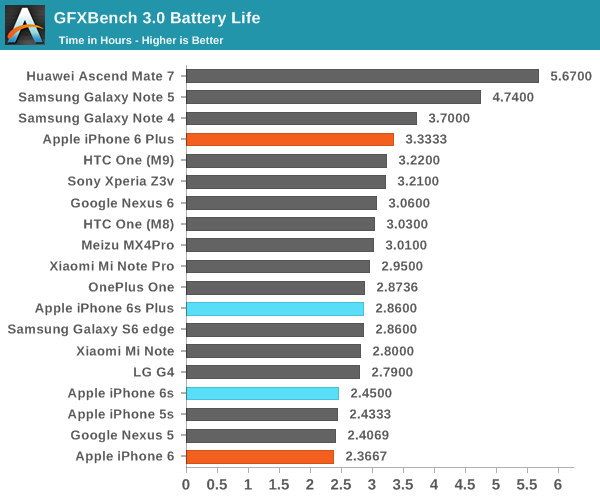
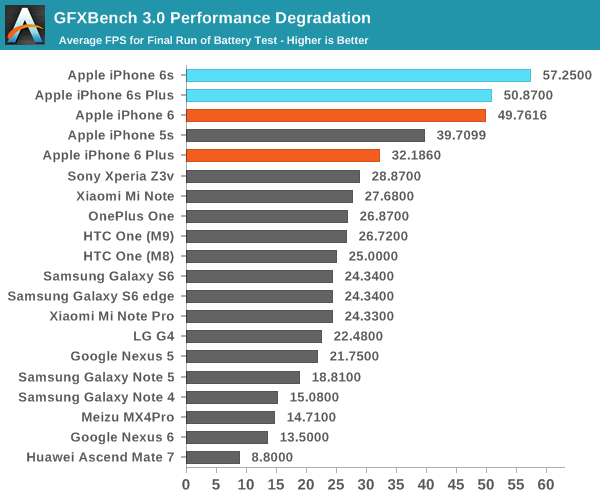
Looking at GFXBench, which is an infinite loop of the T-Rex on-screen benchmark to approximate intensive video gaming we see that the iPhone 6s doesn’t last very long either, but the performance throughout the test is incredible. Due to 1334x750 display resolution and strong GPU, the iPhone 6s manages to last the entire test without any notable throttling, and effectively pegged at the refresh rate of the display. The iPhone 6s Plus manages a similar level of performance but over time you can start to see some throttling, likely a function of the longer runtime and higher display resolution. It’s interesting to see how in the space of two years just how much progress has been made here in terms of improving GPU performance and efficiency, as when we first ran this test it was probably one of the most stressful tests out there for any smartphone or tablet.
Charge Time
Of course, while battery life is usually the main determinant of overall mobility it’s often important to consider charge time. A phone that charges slowly can be much less mobile than another phone, even if it has better battery life. In the case of the iPhone 6s’, it seems that Apple continues to ship the standard 5W charger that they have for many generations in the smartphone industry. In order to see how this charger and phone combination performs, we use our usual methods of timing the phone from fully discharged to fully charged.
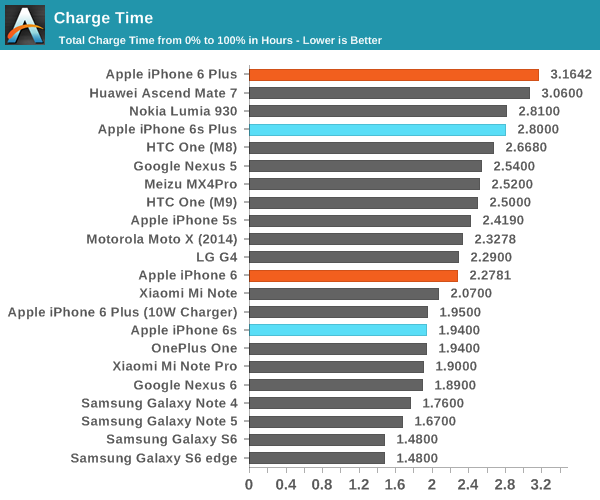
Here, the iPhone 6s and 6s Plus both show a decent improvement over the iPhone 6 and 6 Plus, but not enough to make an significant difference. The iPhone 6s charges at a pretty reasonable rate, but the iPhone 6s Plus really does need a more powerful charger than it does now. You can use an iPad charger to bring things back up to speed but getting this means that you either have to have an iPad already or you have to go out and buy an iPad charger, which is on the annoying side when Android OEMs generally include fast chargers in the box.




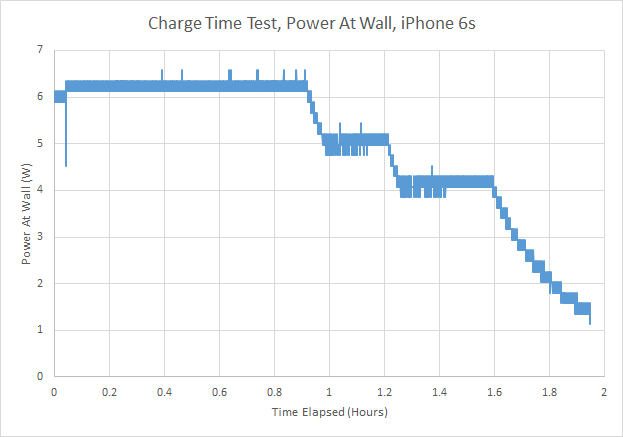
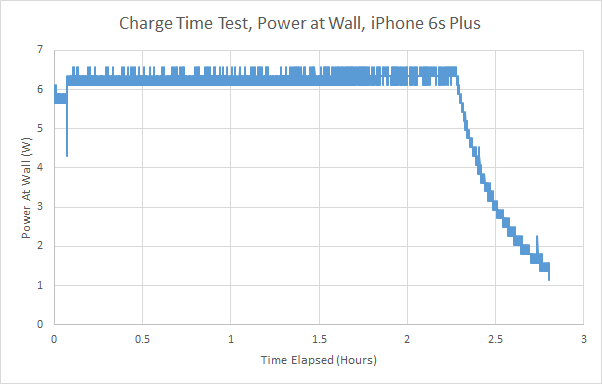








531 Comments
View All Comments
osxandwindows - Tuesday, November 3, 2015 - link
Ios problem other iPhones have it not mine tho.kmmatney - Tuesday, November 3, 2015 - link
I haven't done real tests, but overall I'd say my 6S plus has better audio that any other smartphone we've owned. So I've compared it against other iPhone and Android models, but I've never compared to the HTC M1. Nothing to complain about, for sure, onboard sound is clean and relatively loud when needed.mashuri - Wednesday, November 4, 2015 - link
Has their audio hardware changed in any notable way?mashuri - Wednesday, November 4, 2015 - link
BTW, no hissing or buzzing on my 6s+. Very clean sound on my headphones and earbuds.elpadrino27 - Tuesday, November 3, 2015 - link
I'm happy I bought the iPhone 6S Plus. Feels great after switching from the 5S. Just to let you guys know, in India, the iPhone 6S plus models are shipping with 10W power bricks in the box :)zeeBomb - Tuesday, November 3, 2015 - link
I heard of that...I guess India has more smartphone enthusiasts than here! But really, I hope apple can fix that in 2016.davidbressler - Tuesday, November 3, 2015 - link
Minor "correction" (I think).In the first table comparing the change from the 6 (both versions) to 6s (both versions) I think you left out the new front camera flash (the selfie flash). It's significant in that Apple created a new chip to drive turning the display into a flash.
David
metayoshi - Tuesday, November 3, 2015 - link
I'm surprised and very excited to hear that the iPhone 6s is using NVMe as their storage interface protocol. We're living in an exciting future.Turbofrog - Tuesday, November 3, 2015 - link
I fundamentally disagree with the technical assessment you guys have with respect to the camera. It's indefensible that Apple chose to use such a small sensor for their new camera given that the standard for flagship quality has moved forward since the iPhone 6 last year.I understand your argument for Z-height, but one could simply use the same physical focal length and accept the wider field of view. This is possible because the iPhone sensor possesses no actual technical advantages over it's competitors, it merely benefits from Apple's image processing expertise.
In essence, there is an iPhone sensor available to crop down to inside every single Galaxy S6, LG G4, or Lumia 950. With 12MP in 17.3mm^2, that's essentially the same pixel density that its 16MP or 20MP larger sensor competitors have. So if you don't like the wider field of view? Simply crop your image, and you will have the same pixel-level quality (absent processing) as you're getting from the iPhone for free.
And I would argue that given how much processing goes on behind the scenes to correct every single facet of a smartphones imaging chain, the geometric distortion associated with a wider lens, larger image circle, or faster aperture is really a moot point. There's probably a reason that you don't have access to the RAW files coming from an iPhone, and it's not because they look amazing. There are already dozens of lossy operations going on to correct distortion, remove chromatic aberration and colour casts, and lighten vignetting. It's not as if the iPhone's slower lens visibly demonstrates dramatically sharper corners or more detail than its competition, so again I don't understand why you are defending this decision.
TL;DR - the iPhone sensor and lens are technically behind the competition, a decision which only reduces image quality, and can only be realistically defended on the basis of cost-reduction measures.
JoshHo - Friday, November 6, 2015 - link
A wider field of view causes different optical compromises to be taken. In order to maintain acceptable MTF at the edges detail at the center of the photo is often compromised in response. Given the enormous issues I've seen with the Xperia Z3v with distortion, field curvature, and other aberrations I would need evidence to really believe this.